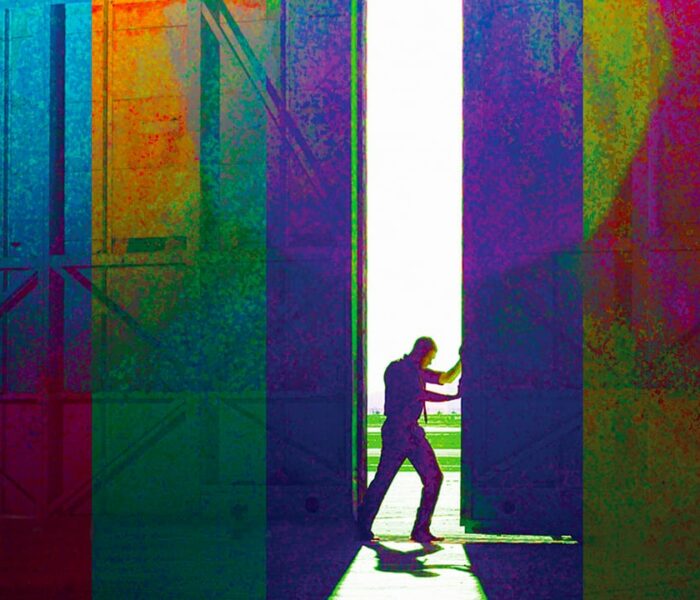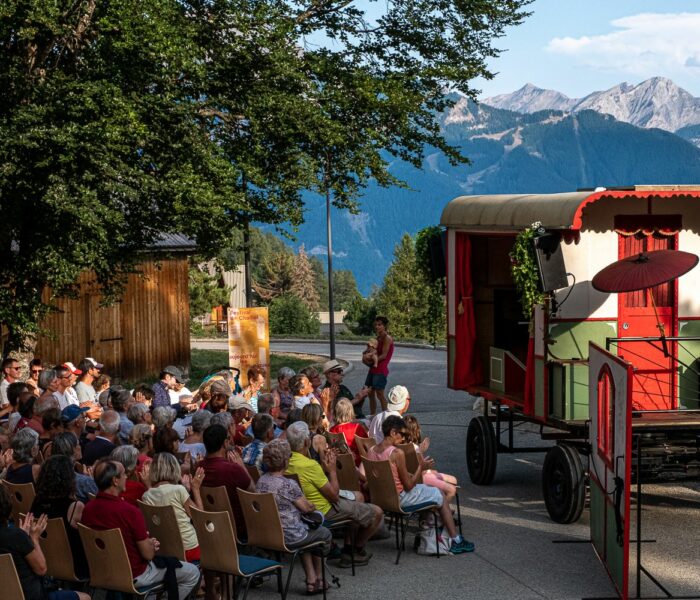Du siècle passé à aujourd’hui, les expérimentations pianistiques en tout genre sont allées bon train. Toujours dans le même sens : changer notre perception de cet instrument-phare et bousculer notre façon de l’entendre. De Henry Cowell à Claudine Simon ou Eve Egoyan, retour sur des expérimentations qui ont chamboulé notre fameux clavier à 88 touches, et amené le public à renouveler son attention.
En 1802, à Prague, le compositeur tchèque Václav Jan Tomášek raconte avoir entendu le compositeur et pianiste Jan Ladislav Dussek en concert et avoir été surpris par sa façon de disposer son piano sur scène. La légende veut que Dussek ait été doté d’un très beau profil et qu’il désirait en faire profiter l’auditoire ; aussi il prit l’habitude de placer le piano de biais afin que ses dames puissent admirer. Pour une simple question esthétique, la scénographie pianistique est changée à jamais. Autre histoire : en 1832, un Hongrois du nom imprononçable de Liszt (un bon Français dit Litz), adolescent virtuose du piano, ose donner un concert entièrement seul : pas de première partie, pas d’autres instrumentistes et pas de danses ou autres pour divertir entre deux morceaux. Le récital est né. Quelques années auparavant, une pianiste de moins de vingt ans se met à jouer des œuvres extrêmement difficiles de Beethoven en se passant de la partition. Clara Schumann – car c’est elle -, dans sa volonté de se distinguer de ces messieurs, tente l’impensable : jouer par cœur des pièces à la virtuosité telle que seul un homme était censé s’y mesurer. Depuis, jouer les yeux au ciel est devenu la norme.
On le voit à travers ces trois exemples : c’est au XIXe siècle qu’un certain rapport au public fut bouleversé – et pour toujours. Le piano, cet instrument que l’on dit roi (mais qui au fond n’est simplement que bourgeois), est l’instrument qui, dans l’Histoire de la musique, a suscité le plus de créations musicales et d’innovations techniques. Il suffit de voir le rayon des partitions pour piano d’un magasin de musique ou de se perdre sur IMSLP (International Music Score Library Project) pour prendre la (dé)mesure de ce répertoire dont le XIXe siècle fut l’apogée.
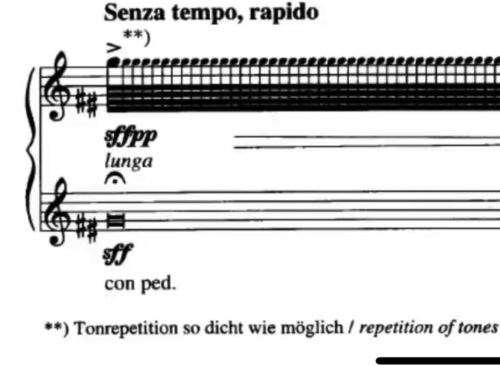
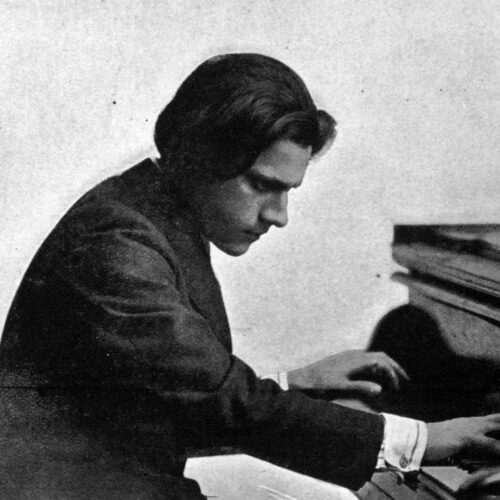
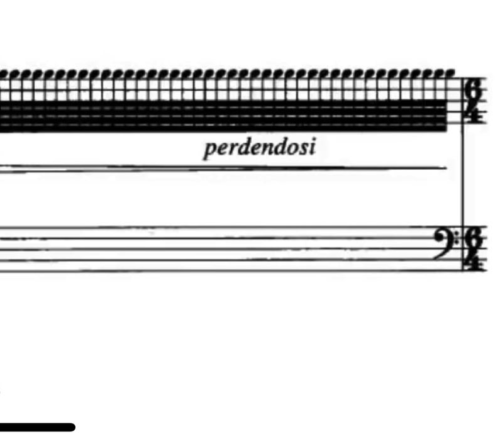
Un violent précurseur
Né en 1893 en Ukraine et émigré aux États-Unis en 1906, Leo Ornstein passe pour être l’inventeur du cluster : cette technique musicale qui consiste à jouer conjointement des notes simultanément (en grappe) sans volonté de former un accord « classé ». Le résultat reste encore aujourd’hui à l’oreille toujours aussi saisissant et percutant. Mort en 2022 à l’âge admirable de cent huit ans, Ornstein eut une jeunesse tumultueuse et fut l’un des compositeurs les plus innovants de son temps (et l’un des plus violemment critiqués). Il se fait rapidement une réputation de pianiste virtuose, ardent défenseur des œuvres de ses contemporains (Schönberg, Scriabine, Bartók, Stravinsky, etc.), tout en intégrant dans ses récitals ses œuvres personnelles aux innovations inouïes en leur temps (clusters, mélodies martellato, rythmique heurtée et attaques brutales). Ornstein lui-même était étonné par sa propre violence (et celle du public) : « Au début, je doutais vraiment de ma santé mentale. Lors de mon deuxième concert consacré à mes propres compositions, j’aurais pu jouer n’importe quoi, je n’entendais pas le piano moi-même. La foule sifflait et hurlait, et jetait des objets sur la scène. » À partir de 1920, son langage s’assagit et revient puiser dans ses racines slaves romantiques. Ces quelques années révolutionnaires laisseront place à une musique néoromantique mais toujours aussi virtuose. Ornstein n’eut plus le souci de se produire en public et de promouvoir sa musique et tombera dans un relatif oubli. Sans lui, Henry Cowell ou John Cage n’auraient sans doute pas reçu l’impulsion de leurs innovations.
L’autopsie pianistique
C’est donc au début du XXe siècle, aux États-Unis, que naît une envie assumée d’élargir la palette sonore du piano, à travers des façons de le jouer, de (mal)traiter l’instrument plutôt que le langage musical lui-même. Le vieux continent européen est quant à lui musicalement écartelé entre un atonalisme naissant (Schönberg, Scriabine) qui donnera vie au sérialisme (Berg, Webern) et la vision harmonique plus élargie – mais toujours sous contrôle – de Debussy, Fauré et Schmitt. Ce monde musical au lourd héritage wagnérien ne cherche pas à utiliser le piano autrement qu’avec ses doigts – au jeu perlé de préférence. De l’autre côté de l’Atlantique, l’expansion bruyante du modernisme industriel a certainement contribué à influencer les compositeurs dans cette « nouvelle musique » mécanique, répétitive et implacable. Musique qui devait trouver sa place avec le jazz naissant des Afro-Américains.
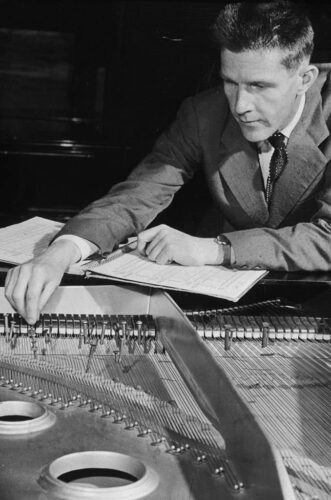
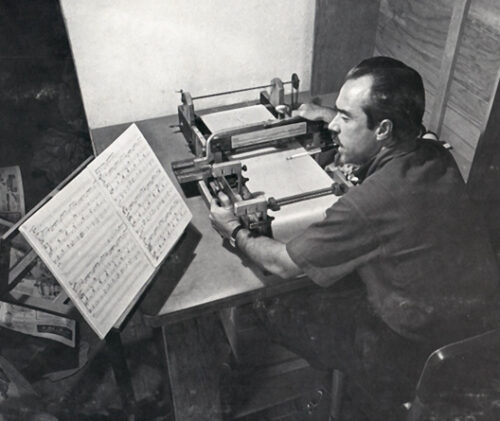
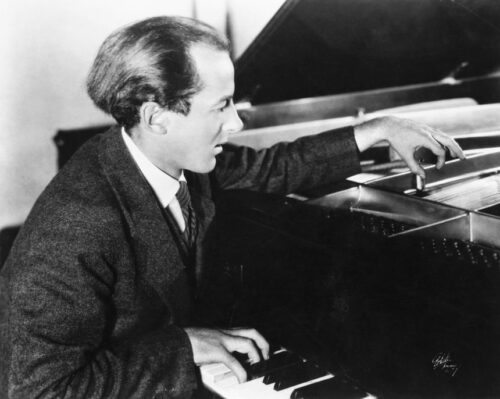
Après Ornstein, un mouvement est lancé : Henry Cowell, John Cage, Conlon Nancarrow se mettent à leur tour à « réinventer » la texture pianistique. Cowell développe et popularise la technique du cluster et parvient à lui donner une dimension musicale d’une grande intensité dans ses Three Irish Legends ; il est également le premier à ordonner au pianiste de jouer directement à l’intérieur du piano en grattant, tapant ou caressant les cordes. Cage quant à lui se met à préparer la table d’harmonie en glissant boulons et vis dans les cordes afin de transformer directement le son du piano : le fameux piano préparé. Cette technique révolutionnaire ne cesse d’inspirer encore aujourd’hui les pianistes (de François Tusques et Benoît Delbecq à Ève Risser). Pour l’anecdote, c’est pour la chorégraphe Syvilla Fort que John Cage improvise et découvre le piano préparé afin de suppléer à l’absence de percussionnistes n’ayant pas la place d’être sur scène… C’est aussi pour remplacer des musiciens que le compositeur mexicain Conlon Nancarrow décide à partir des années 1940 de ne plus composer que pour piano mécanique (invention américaine il va sans dire) afin de pouvoir réaliser des Études d’une complexité technique diabolique que seule une machine pouvait exécuter. Il va sans dire que cela n’a pas aidé à faire connaître sa musique auprès du grand public. Le compositeur et musicologique Kyle Gann résume bien l’attitude esthétique jusqu’au-boutiste de Nancarrow : « Inspiré par Stravinsky, défié par Cowell, il est le seul compositeur à avoir complètement intégré les micro-rythmes de l’un aux macro-rythmes de l’autre, le seul à avoir résolu, plutôt que contourné, le dilemme rythmique Schoenberg/Stravinsky. Nancarrow a réalisé cet exploit, bien sûr, à un prix que peu de compositeurs auraient été prêts à payer : il a sacrifié la possibilité d’une exécution par des humains. »
On peut encore citer Charles Ives, George Crumb, George Antheil, Blind Tom Wiggins qui tous furent des précurseurs dans l’explosion mécanique du piano romantique. Crumb qui, par exemple dans ses Makrokosmos (1972), demande au pianiste de jouer à l’intérieur du piano, de siffler dedans, chanter tout en jouant de façon à faire entrer en résonance la table d’harmonie, déclamer du texte, frapper non seulement les touches mais aussi le bois, etc.
Une nouvelle lutherie
Parfois la technologie demande à la créativité de s’adapter. Il arrive bien souvent que ce soit l’inverse qui se produise. Une innovation apparaît, des artistes se l’accaparent, l’améliorent et la transcendent. À partir des années 80, triturer le piano et chercher des sonorités de manière acoustique sans amplification n’a plus suffi. Des compositeurs se sont donc mis à écrire pour piano et bande-son (Luc Ferrari, Jonathan Harvey, François Sarhan) afin d’intégrer d’autres sons que ceux du piano (nature, autres musiques, bruits etc). Le field-recording s’est invité dans le répertoire pour piano avec de splendides réussites : Collection de petites pièces ou « 36 Enfilades » (1984) de Luc Ferrari ou encore Série Bleue de Pierre Jodlowski (2013).
Mais depuis quelques années, une nouvelle ère est apparue dans la sphère pianistique : le piano étendu. Plusieurs termes coexistent afin d’identifier cette nouvelle approche liée à la facture où la technologie étend les capacités musicales de ce vieil instrument. La pianiste française Claudine Simon est une des figures majeures dans ce domaine avec son concept de pianomachine : « « Cette technologie me donne la possibilité d’ouvrir un nouvel espace de jeu à l’intérieur du piano, d’en faire une sorte d’autopsie sonore. En greffant des machines dans le corps du piano, je me rapproche de la notion de “machine désirante” envisagée aussi comme un « corps sans organe » propre aux réflexions de Deleuze et d’Artaud. » Le pianiste Edouard Ferlet de son côté explore le rapport entre l’homme et la machine – toujours elle – dans un de ses derniers disques, Pianoïd, où il utilise le Disklavier de Yamaha comme un nouvel instrument hybride, à mi-chemin entre le synthétiseur et le piano traditionnel. Il le dit lui-même : « Cet instrument me permet de produire des sonorités et des modes de jeux que l’homme ne pourrait pas jouer de ses mains tout en respectant une diffusion acoustique et naturelle de la musique. Je m’entoure de deux pianos Yamaha, un Silent et un Disklavier (un piano muni d’une interface informatique, Ndlr.), que je pilote grâce à une surface de contrôle Midi qui va les synchroniser. Ce contrôleur agit sur des paramètres informatiques qui seront joués en acoustique. »
Piano NEXT
La pianiste arméno-canadienne Eve Egoyan se consacre depuis des années à approfondir le répertoire du piano « augmenté ». Elle augmente et élargit la gamme sonore du piano et fait du piano un instrument visuel tout en maintenant la relation physique qui existe entre le piano et la pianiste. Entretien.
Quelle a été la genèse de Piano NEXT ?
J’ai toujours rêvé explorer l’intérieur du son du piano, imaginé que le piano était capable de faire des choses au-delà de ce que l’on sait faire, comme maintenir une note pour toujours ou faire un crescendo sur une note. Sur un piano acoustique, le son décroît naturellement une fois qu’une note est frappée, et le pianiste ne peut pas empêcher le son de disparaître (sauf en superposant plus de notes). Sous les auspices généreux du Conseil des arts du Canada, j’ai pu développer ce que j’appelle Piano NEXT. À l’époque, je travaillais avec un Disklavier.
Comment ce logiciel joue-t-il exactement avec le son en temps réel du piano ?
Le logiciel lui-même ne modifie pas le son du piano acoustique. Le son du piano lui-même reste inchangé. Bien que j’aie utilisé un Disklavier au début du développement de ce projet, je travaille maintenant avec un scanner pour piano développé par l’Augmented Instruments Laboratory de l’Université Queen Mary de Londres. Ce scanner a des capteurs optiques qui reposent au-dessus du clavier du piano et suivent le mouvement des touches pendant que je joue. Dans mon propre travail pour piano augmenté/acoustique, j’utilise un logiciel qui modélise avec précision tous les paramètres physiques qui déterminent le caractère sonore d’un piano acoustique. Ce logiciel me permet de modifier n’importe laquelle de ces caractéristiques physiques (longueur des cordes, dureté du marteau, rigidité de la harpe, vibrations sympathiques, etc.) en temps réel. Cela me permet d’étendre le caractère du son du piano en dehors de sa plage normale. Vous entendez à la fois le piano acoustique et le piano modélisé. Par exemple, lorsque le piano acoustique décline, le piano modélisé peut maintenir un crescendo, ce qui donne l’impression qu’un piano acoustique en est à l’origine. Il existe de nombreux types de sons différents que le piano modélisé est capable de produire, par exemple un vibrato, un effet leslie, révélant des harmoniques à différentes hauteurs. Ces sons se mêlent au piano acoustique. Les deux pianos sont, par essence, en duo l’un avec l’autre. J’utilise deux pédales supplémentaires : l’une pour le degré d’expression (par exemple, la vitesse d’un vibrato), l’autre pour faire entrer et sortir le son du piano modélisé, en ajustant son volume par rapport au piano acoustique.
Je peux également déclencher des séquences sonores. Ce sont des enregistrements de sons réels que j’affine dans des logiciels de montage sonore. Par exemple, j’ai enregistré la voix de ma fille pour que, lorsque je joue, l’on entende des notes de piano qui correspondent à sa voix.
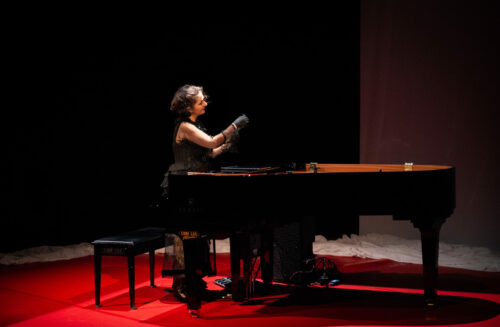
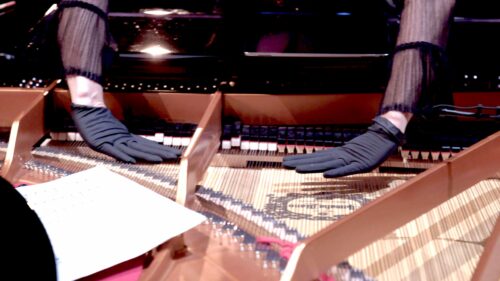
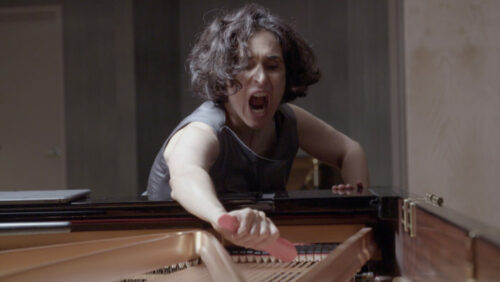
J’ai cru comprendre que vous aviez composé pour cette nouvelle technique de jeu, est-ce une première de composer pour vous-mêmes ?
Piano NEXT m’a permis d’explorer la composition et l’improvisation d’une nouvelle manière. Pendant des années, j’ai interprété le répertoire standard et des œuvres de compositeurs vivants. De nombreux compositeurs ont également écrit pour moi des œuvres à créer. J’aime le répertoire. Cependant, cet amour profond pour ce que je joue a également rendu difficile la recherche de ma propre voix en tant que créatrice. Je suis remplie des langages musicaux des autres. Recréer le piano pour moi-même m’a permis de développer un langage unique qui m’engage et m’inspire à écrire davantage.
Que pensez-vous que cela apporte au public ?
Le piano a une histoire incroyable. En ré-imaginant le piano de cette manière, j’essaie d’amener cet instrument estimé dans un nouvel endroit. Il est assez naturel d’écouter Piano NEXT tant les interventions sont assez discrètes, et pourtant c’est quelque chose d’extraordinaire et de magique à la fois.
François Mardirossian



)
